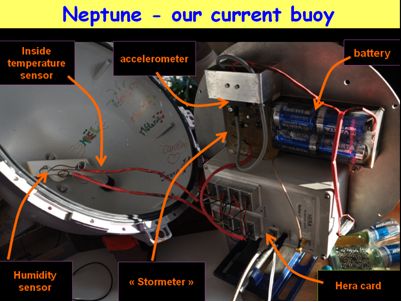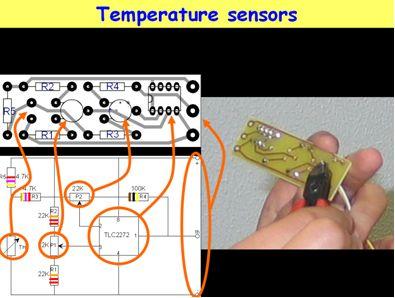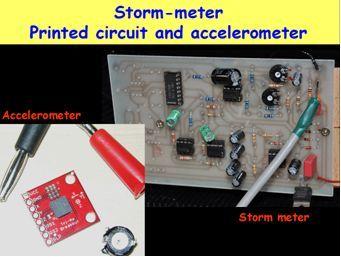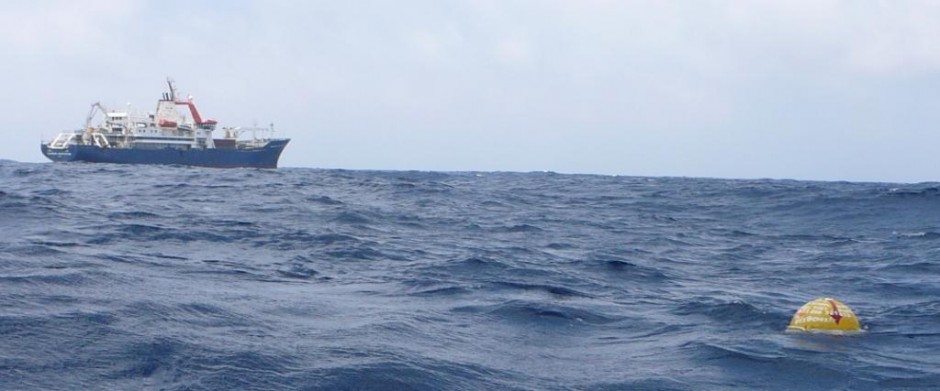Since last week, GeoLog has had the pleasure to host reports from Teachers at Sea. This educational programme, co-sponsored by the European Geosciences Union (EGU) and the French Polar Insitute (IPEV), gives school teachers the opportunity to take part in oceanographic cruises with scientists. This year, Sandrine Vivier and Ana Sánchez, teachers of Biology and Geology in Rodez (France) and Madrid (Spain), respectively, together with EGU’s Education Chair Carlo Laj, join scientists on board of the Marion Dufresne. The research vessel is navigating the South China Sea where teachers will work alongside scientists in collecting marine sediments to retrieve the secrets of deep ocean circulation and understand past variations of the Asian Monsoon.
Report 8: A student experiment enters a new stage
The last coring site, which we’ve reached earlier this week, appeared to be a good place to cast off ‘our’ buoy, Neptune. What is this, you may ask? Neptune is an oceanographic buoy made by students in Lycée Monteil in Rodez, France and by the CNES (Centre National d’Etudes Spatiales) as part of Argonautica, a project to educate students about the marine environment and the climate.
The device provides data through Argos, a system for worldwide tracking and environmental monitoring by satellite. The system receives messages from markers fixed on animals or on buoys all around the world.
This scientific adventure began in 2008 when Sandrine and her students decided to study marine currents in order to understand the link between the weather and the oceans. The first buoy they built in the remit of this project, named Venus, was cast off in the Mediterranean Sea in November 2009 at the 43rd parallel offshore. It contained sensors made by the Monteil students themselves, which were able to measure temperature and luminosity at different depths inside and outside the buoy.
Unfortunately, it worked for less than three days. But Sandrine and her students decided not to give up and built a new buoy to continue their marine-currents study. And, since then, the project has progressively gathered more supporters at the French high school: just in 2012, 50 students between 15 and 18 years old have worked on it.
On board of the Marion Dufresne, Sandrine has been testing the second buoy, Neptune, since the start of the cruise. The tests showed all sensors functioning correctly, and water tightness was checked in a swimming pool on board.
There are many components in Neptune, and all need to be carefully checked. The ‘Hera card’, supplied by CNES and the French society Tenum transmits data to a satellite, while specific sensors measure temperature and humidity inside the buoy. The device needs batteries to work, of course, and these are covered in resin in order to resist as long as possible in water.
A key Neptune instrument is the ‘stormeter’ (or storm-meter), which is able to measure the amplitude and frequency of waves. It contains an accelerometer to measure gravity, and the signal obtained in this way is then filtered and amplified. After filtering to eliminate high frequency results, a signal oscillates between a maximum and a minimum level thanks to an operational amplifier. Sandrine students will know that the difference between the maximum and minimum levels is proportional to the amplitude of the entry signal and to the wave amplitude via a calibration curve established in class in previous experiments. The buoy serves to teach physics as well as marine science!
Just before the coring in the last site, Hélène Leau, the Operations Manager of the French Polar Institute, allowed us to prepare the buoy. Members of the crew helped Sandrine fix a floating anchor to it and a weight at the end of the line of anchorage (a 40-metre electric cable under the buoy).
Then, the captain gave permission to Carlo to temporarily leave the Marion Dufresne on a small raft. He wanted to take pictures of Neptune in the water, and also to film a Casq coring from outside the ship!
Neptune had a successful 24 hours covering12.5 miles in the northwest direction. With all sensors functioning correctly, the buoy continues its path towards the north of the South China Sea. The students have reasons to be proud!
By Sandrine Vivier, Ana Sánchez, and Carlo Laj





Belastingschijven
Hands on science, is there any better way to breed and new crop of scientists. There is no substitute for showing the student the beauty of nature first hand.